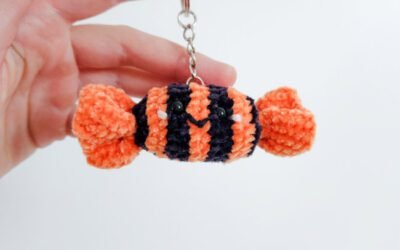Crochet for beginners : Which crochet hook to choose?
Crochet is a textile creation technique that uses a single tool, simply called a hook, to create interlocking stitches from yarn or thread. This method, popular for its versatility and ease of learning, allows for a wide variety of projects ranging from clothing and decorative accessories to cute stuffed animals.
The Different Crochet Hook Materials
Choosing the right material for your crochet hook is essential to optimize your crafting experience. Each type of hook – whether plastic, bamboo, or steel – has unique advantages and disadvantages that can influence your comfort and efficiency.
Plastic Crochet Hooks
Plastic hooks are popular among beginners and occasional crocheters due to their lightness and affordability.
Advantages
- Lightweight and Manageable: Plastic hooks are generally very light, making them easy to handle.
- Economical: They are often the cheapest on the market, making them a good choice for those starting out or not wanting to invest immediately in more expensive equipment.
- Variety of Colors and Sizes: Available in a multitude of colors and sizes, they allow for easy and attractive customization!
Disadvantages
- Less Durable: Plastic can warp or break more easily than other materials, especially under pressure or intensive use.
- Less Smooth Surface: Sometimes, the finish on plastic hooks isn’t as smooth, which can make yarn glide less easily. (A little tip if your hook has a pronounced irregularity: a quick swipe with a nail file will make it more functional!)
- Temperature Sensitivity: Plastic can soften or warp under excessive heat, limiting its use in certain conditions.
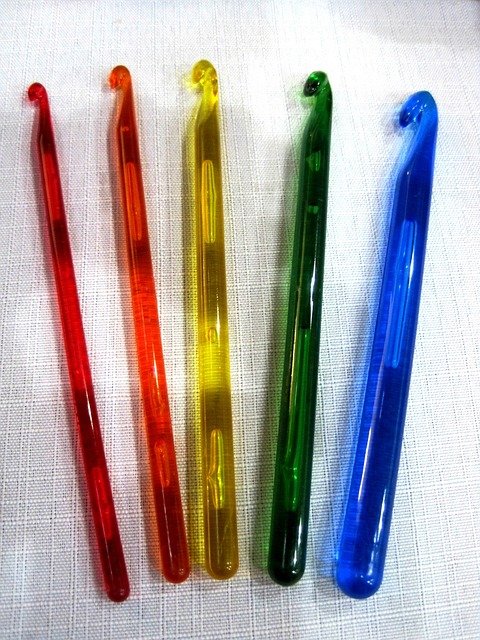
Wood / Bamboo Crochet Hooks
Wood hooks are generally made from bamboo. They are appreciated for their lightness and ecological impact.
Advantages
- Eco-friendly: Bamboo is a renewable and biodegradable resource, making it an environmentally friendly choice.
- Lightweight and Gentle: Like plastic hooks, bamboo ones are light but have a softer, more natural surface, which makes working with various types of yarn easier.
Disadvantages
- Less Robust: Although durable, bamboo can crack or break more easily than steel under excessive pressure.
- Limited Availability: It can be harder to find bamboo hooks in all sizes compared to plastic or steel ones. Bamboo hooks are especially used for projects requiring larger hook sizes.
Steel Crochet Hooks
Steel hooks are renowned for their durability and precision, ideal for experienced crocheters and detailed projects.
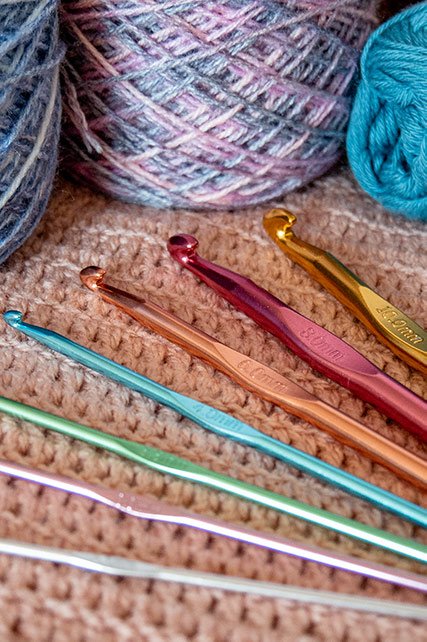
Advantages
- Extremely Durable: Steel hooks are the most robust and durable, capable of withstanding intensive use without deforming.
- Very Smooth Surface: They offer a very smooth surface, allowing yarn to glide easily, which is ideal for delicate work and fine yarns.
- Precision and Control: Thanks to their solidity, they offer great precision and excellent control, essential for detailed and complex projects.
Disadvantages
- Weight: They are heavier than plastic or bamboo hooks, which can cause fatigue during long crochet sessions.
- Cost: Steel hooks are often more expensive, which can be a drawback for beginners or those on a tight budget.
Ergonomic Crochet Hooks
Ergonomic hooks are specially designed to offer optimal comfort by reducing fatigue, allowing you to work longer without pain. Whether you are a beginner or an expert, an ergonomic hook can transform your crochet experience.
Why Choose an Ergonomic Hook?
- Reduction of Fatigue: Ergonomic hooks are designed to reduce strain on your hands and wrists. Their shape and comfortable grip allow for long periods of crocheting without feeling fatigued.
- Pain Prevention: For those suffering from joint pain, arthritis, or carpal tunnel syndrome, ergonomic hooks can be an ideal solution. Their design helps prevent pain and cramps associated with prolonged use.
- Improved Comfort: Ergonomic handles are often made of soft, non-slip materials, providing a more pleasant and secure grip. This allows for easier and more precise handling of the hook.
- Increased Efficiency: With an ergonomic hook, you can work more efficiently. The reduction in fatigue and pain means you can focus more on your project and crochet faster.

Even with the use of an ergonomic hook (or not), there are some basic rules to follow if you want to avoid injury (yes, crochet isn’t without its risks! Repetitive motion without precaution can cause temporary pain or even tendinitis). Before any crocheting session, remember to warm up your wrists and fingers properly. During your session, take regular breaks to give your joints a rest. Take the opportunity to have a drink; hydration is very important for your muscles!
The Best Ergonomic Crochet Hooks
Tulip Etimo
Tulip Etimo hooks are renowned for their comfort and elegant design. These are the ones I use personally every day, and switching from “cheap” hooks to these has been a game-changer for me!
- Comfortable Handles: The soft elastomer handles provide a gentle and comfortable grip, reducing hand and wrist fatigue.
- Precision and Control: The stainless steel tip is perfectly smooth, allowing the yarn to glide easily and offering excellent control.
- Aesthetic and Durability: Available in a variety of sizes, these hooks combine elegance and durability, ensuring a long lifespan.

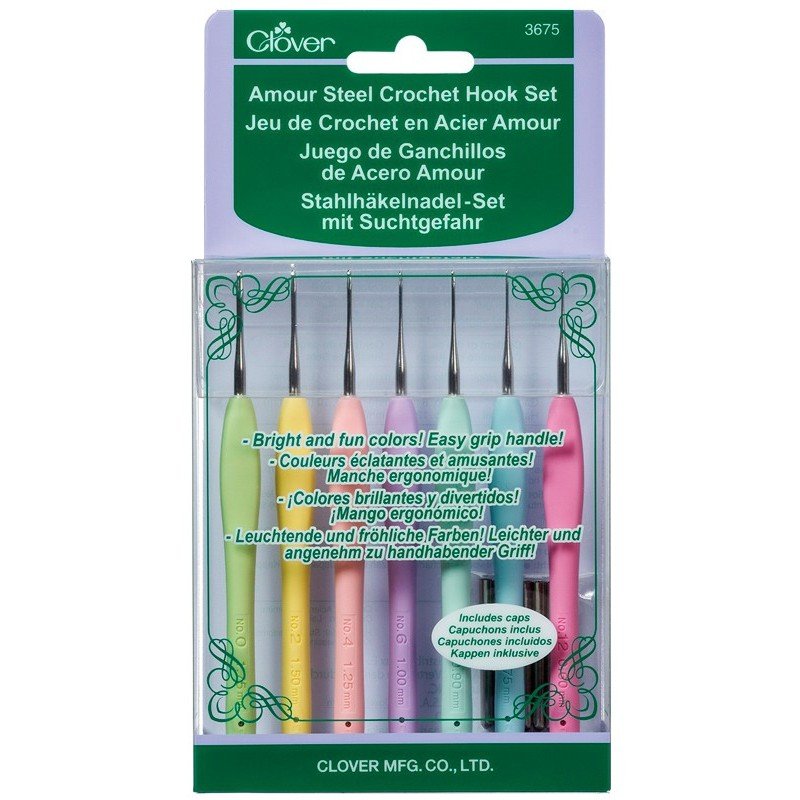
Clover Amour
Clover Amour hooks are appreciated for their quality and exceptional comfort.
- Non-Slip Handles: The soft rubber handles provide a comfortable and non-slip grip, ideal for long crochet sessions.
- Bright Colors: Each hook size has a different color, making them easy to identify quickly.
- Performance and Smoothness: The aluminum or stainless steel tip glides easily through the yarn, ensuring a smooth and enjoyable crocheting experience.

Furls
Furls hooks are famous for their luxurious design and superior ergonomics.
- Ergonomic Design: Furls hooks are designed to fit perfectly in your hand, reducing tension and fatigue in the fingers and wrists.
- High-Quality Materials: Made from high-quality wood, resin, or metal, these hooks are both durable and aesthetically pleasing.
- Comfort and Efficiency: The unique design allows for a natural and comfortable grip, enabling you to crochet longer without discomfort.
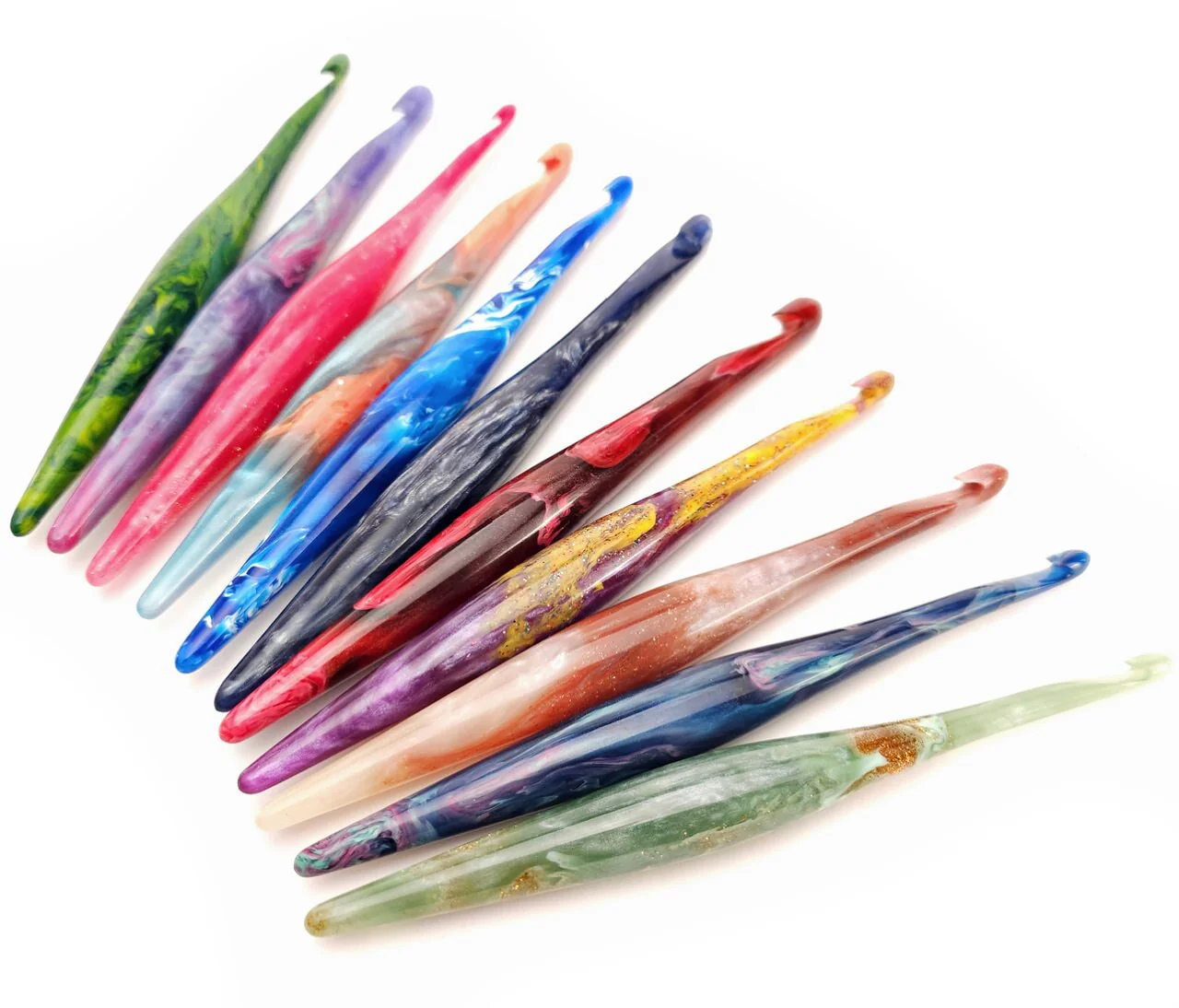
These brands offer ergonomic hooks that combine comfort, performance, and durability. No matter which brand you choose, you will benefit from high-quality tools!
How Do Yarn Labels Help Choose the Ideal Hook?
When you embark on a crochet project, one of the crucial steps is choosing the right hook based on the yarn you use. Yarn labels are valuable guides that provide all the necessary information to make this choice.
Key Information on the Label
Yarn labels contain several essential pieces of information that guide you in selecting your hook. Here are the main elements to look for:
Type of Yarn: The label indicates the type of yarn (wool, cotton, acrylic, etc.), which can influence the hook choice. For example, thicker yarns like chunky wool require larger hooks, while finer yarns like mercerized cotton need smaller hooks.
Yarn Weight: The weight of the yarn indicates its thickness. Common categories are Fingering, Sport, DK (Double Knit), Worsted, Aran, Bulky, and Super Bulky. Each weight category corresponds to a range of recommended hook sizes.
Recommended Hook Size: The label often includes a recommended hook size, indicated in millimeters (mm) or US sizes. This recommendation is based on tests conducted by the manufacturer to achieve the best texture and flexibility of the fabric.
Gauge: The label may also provide gauge information, i.e., the number of stitches and rows needed to reach a certain dimension with a specific hook. This helps you adjust your hook size to achieve the right tension.
Care Instructions: Although not directly related to hook size, knowing the care instructions for the yarn (washing, drying, ironing) can influence your choice of project and yarn.

Matching Yarn Type and Hook Size
Understanding the correspondence between yarn type and hook size is crucial to getting the best results in your crochet projects. Here is a general correspondence table to help you choose the ideal hook based on the yarn weight:
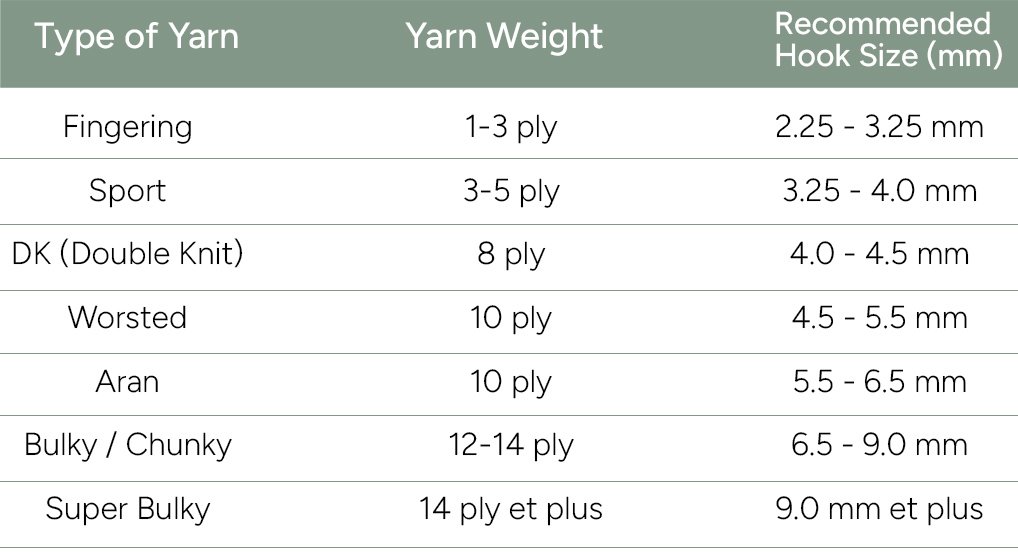
This correspondence may vary slightly depending on the manufacturer and the nature of the yarn, but it’s a good starting point. Always experiment by making a sample to ensure you get the desired texture and tension for your project.
By using the information provided on the ball label and understanding the correspondence between yarn type and hook size, you’ll be better equipped to choose the ideal hook for your creations. This will help you avoid frustration and ensure that your crochet project runs smoothly, with an end result that lives up to your expectations.
The Different Crochet Hook Sizes
Measurement Systems: MM & US
Crochet hooks are typically measured in millimeters (mm) internationally, which indicates the diameter of the hook’s shaft (the part that forms the stitches). However, in some countries like the United States, hooks are also identified by letters or numbers, creating a distinct measurement system.
Millimeter System (MM): Used worldwide, this system is simple and precise. Hook sizes generally range from 0.5 mm to 25 mm, covering a wide range of projects from the finest to the bulkiest.
US Size System: In the United States, hooks are classified by letters (A to Q) and by numbers (B-1, C-2, etc.). Each letter or number corresponds to a specific size in millimeters. This system may seem confusing at first, but it becomes intuitive with a bit of practice.
Conversion Table Between MM and US
To help you navigate between these two systems, here is a conversion table between crochet hook sizes in millimeters and US sizes:
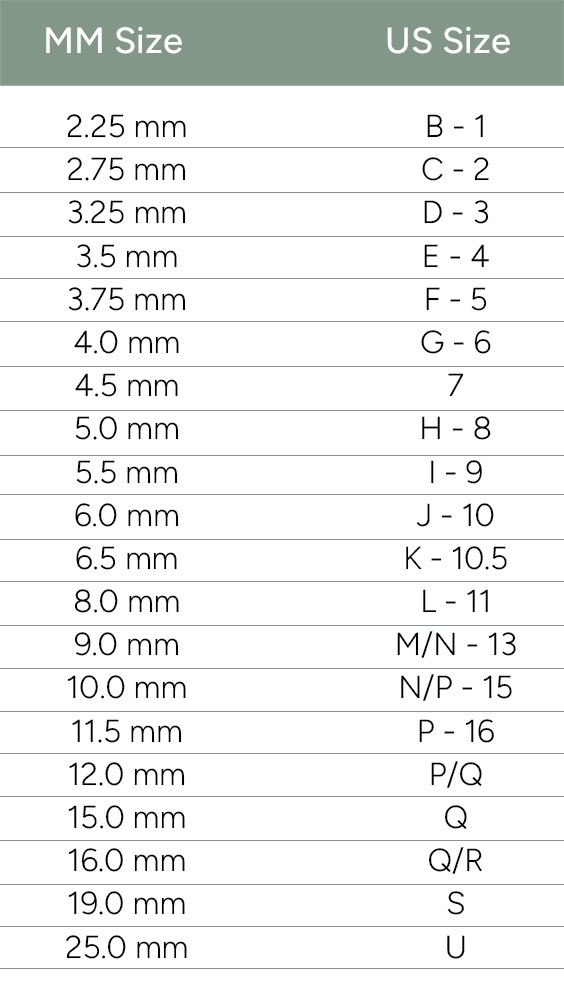
This conversion table will help you choose the right hook when working with patterns or yarns that use different measurement systems. It’s important to note that manufacturers may sometimes have slight variations in sizes, so checking the specific recommendations for your project is always a good idea.
Ultimately, the choice of hook depends on your personal preferences, comfort, and the type of project you’re undertaking. Experiment with different hooks to find the one that suits you best, and unleash your creativity in your crochet projects. Happy crocheting!
Discover our other Crochet articles:
Crochet Halloween Candy – Free Pattern for Keychain
Explore the steps for making a candy key ring with this free crochet pattern, which is easy to follow and quick to make.
Crochet Squid – Free Pattern for Keychain
Explore the steps for making a squid-shaped key ring with this free crochet pattern, which is easy to follow and quick to make.
Crochet Fish – Free Pattern for Keychain
Explore the steps for making a fish-shaped key ring with this free crochet pattern, which is easy to follow and quick to make.

by Katy
Creator of Yarn & Crochet

